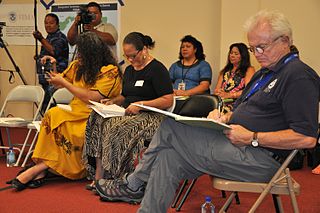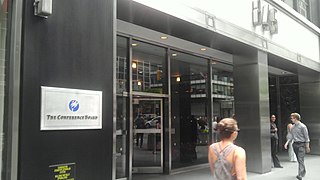Related Research Articles

Public relations (PR) is the practice of managing and disseminating information from an individual or an organization to the public in order to influence their perception. Public relations and publicity differ in that PR is controlled internally, whereas publicity is not controlled and contributed by external parties. Public relations may include an organization or individual gaining exposure to their audiences using topics of public interest and news items that do not require direct payment. The exposure is mostly media-based, and this differentiates it from advertising as a form of marketing communications. Public relations often aims to create or obtain coverage for clients for free, also known as earned media, rather than paying for marketing or advertising also known as paid media. However, advertising is also a part of broader PR activities.

A chief executive officer (CEO), also known as a chief executive or managing director, is the top-ranking corporate executive charged with the management of an organization, usually a company or a nonprofit organization.
A chief operating officer (COO), also called chief operations officer, is an executive in charge of the daily operations of an organization. COOs are usually second-in-command immediately after the CEO, and report directly to them, acting on their behalf in their absence.
Investor relations (IR) is a "strategic management responsibility that is capable of integrating finance, communication, marketing and securities law compliance to enable the most effective two-way communication between a company, the financial community, and other constituencies, which ultimately contributes to a company's securities achieving fair valuation." as defined by National Investor Relations Institute (NIRI). IR is also function to assess the impact of a company actions on the company's position in the capital markets.
CCO or cco may refer to:

Internal communications (IC) is the function responsible for effective communications among participants within an organization. The scope of the function varies by organization and practitioner, from producing and delivering messages and campaigns on behalf of management, to facilitating two-way dialogue and developing the communication skills of the organization's participants.
The chief risk officer (CRO), chief risk management officer (CRMO), or chief risk and compliance officer (CRCO) of a firm or corporation is the executive accountable for enabling the efficient and effective governance of significant risks, and related opportunities, to a business and its various segments. Risks are commonly categorized as strategic, reputational, operational, financial, or compliance-related. CROs are accountable to the Executive Committee and The Board for enabling the business to balance risk and reward. In more complex organizations, they are generally responsible for coordinating the organization's Enterprise Risk Management (ERM) approach. The CRO is responsible for assessing and mitigating significant competitive, regulatory, and technological threats to a firm's capital and earnings. The CRO roles and responsibilities vary depending on the size of the organization and industry. The CRO works to ensure that the firm is compliant with government regulations, such as Sarbanes–Oxley, and reviews factors that could negatively affect investments. Typically, the CRO is responsible for the firm's risk management operations, including managing, identifying, evaluating, reporting and overseeing the firm's risks externally and internally to the organization and works diligently with senior management such as chief executive officer and chief financial officer.
Director of communications is a position in both the private and public sectors. A director of communications is responsible for managing and directing an organization's internal and external communications. Directors of communications supervise public relations staff, create communication strategies, and may serve as the key spokesperson and media contact for the organization.

The Conference Board, Inc. is a 501(c)(3) non-profit business membership and research organization. It counts over 1,000 public and private corporations and other organizations as members, encompassing 60 countries.
Corporate communication(s) is a set of activities involved in managing and orchestrating all internal and external communications aimed at creating a favourable point of view among stakeholders on which a company depends. It is the messages issued by a corporate organization, body or institute to its audiences, such as employees, media, channel partners and the general public. Organizations aim to communicate the same message to all its stakeholders, to transmit coherence, credibility and ethics.
Chief channel officer (CCO) is a corporate title for the person responsible for all indirect revenue with a partner within an organization. The Channel Chief typically reports to the chief executive officer (CEO) as a corporate officer or to the chief operating officer (COO). The CCO is usually an executive or senior vice president position.
A chief customer officer (CCO) is the executive responsible in customer-centric companies for the total relationship with an organization’s customers. This position was developed to provide a single vision across all methods of customer contact. The CCO is often responsible for influencing corporate activities of customer relations in the call centre, sales, marketing, user interface, finance (billing), fulfillment and post-sale support. The CCO typically reports to the chief executive officer, and is potentially a member of the board of directors.
Ed Dandridge is a corporate executive who is currently an executive vice president and chief marketing & communications officer at AIG.
The chief commercial officer (CCO) is an executive-level role, with the holder being responsible for the commercial strategy and the development of an organization. It typically involves activities relating to marketing, sales, product development and customer service to drive business growth and market share. As a corporate officer position, the CCO generally reports directly to the chief executive officer (CEO) and is primarily concerned with ensuring the integrated commercial success of an organization. The role typically must combine technical knowledge of the relevant field with strong marketing and business development skills.
The chief governance officer (CGO) is normally a senior vice executive reporting to the CEO; however, in the not-for-profit sector, when an organization uses policy governance, the chair of the board often takes on the role of CGO, who is tasked with directing the people, business processes and systems needed to enable good governance from inside the corporation in support of the board of directors. In some geographies the role is assumed by the chief counsel, in others by a corporate or company secretary.
A chief reputation officer (CRO) is an executive-level position at a corporation, company, organization, or institution, typically reporting directly to the CEO or board of directors and belonging to the executive board of directors.
Cunningham Communication, Inc. was a prominent public relations firm in Silicon Valley in the 1980s and 1990s that had many well-known clients in high-tech, including Adobe, Cisco, Motorola, PeopleSoft, Hewlett-Packard, and the IBM Consumer Division. It was founded by Andy Cunningham in 1985, after she left Regis McKenna.
Mike Fernandez is a business executive who has led communications, marketing, government relations and sustainability for a number of large companies. Fernandez also served as the US CEO for two agencies, Burson-Marsteller and Llorente y Cuenca. He was a full-time professor of practice at Boston University and an adjunct professor at several universities. He currently is the senior vice president of public affairs, communications and sustainability at Enbridge which is headquartered in Calgary, AB, Canada.
A communications manager, sometimes called public relations manager or pr manager, is a person entrusted with the management of strategic, goal-oriented communication processes between organizations and their respective stakeholders.
References
- ↑ Bika, Nikoletta (2017-03-15). "Public Relations (PR) Officer job description". Recruiting Resources: How to Recruit and Hire Better. Retrieved 2022-11-17.
- ↑ "The New CCO: Transforming Enterprises in a Changing World" Archived August 23, 2022, at the Wayback Machine Arthur W. Page Society
- ↑ "The Chief Communications Officer: A Survey of Fortune 200 Companies" Korn/Ferry Institute, April 2009